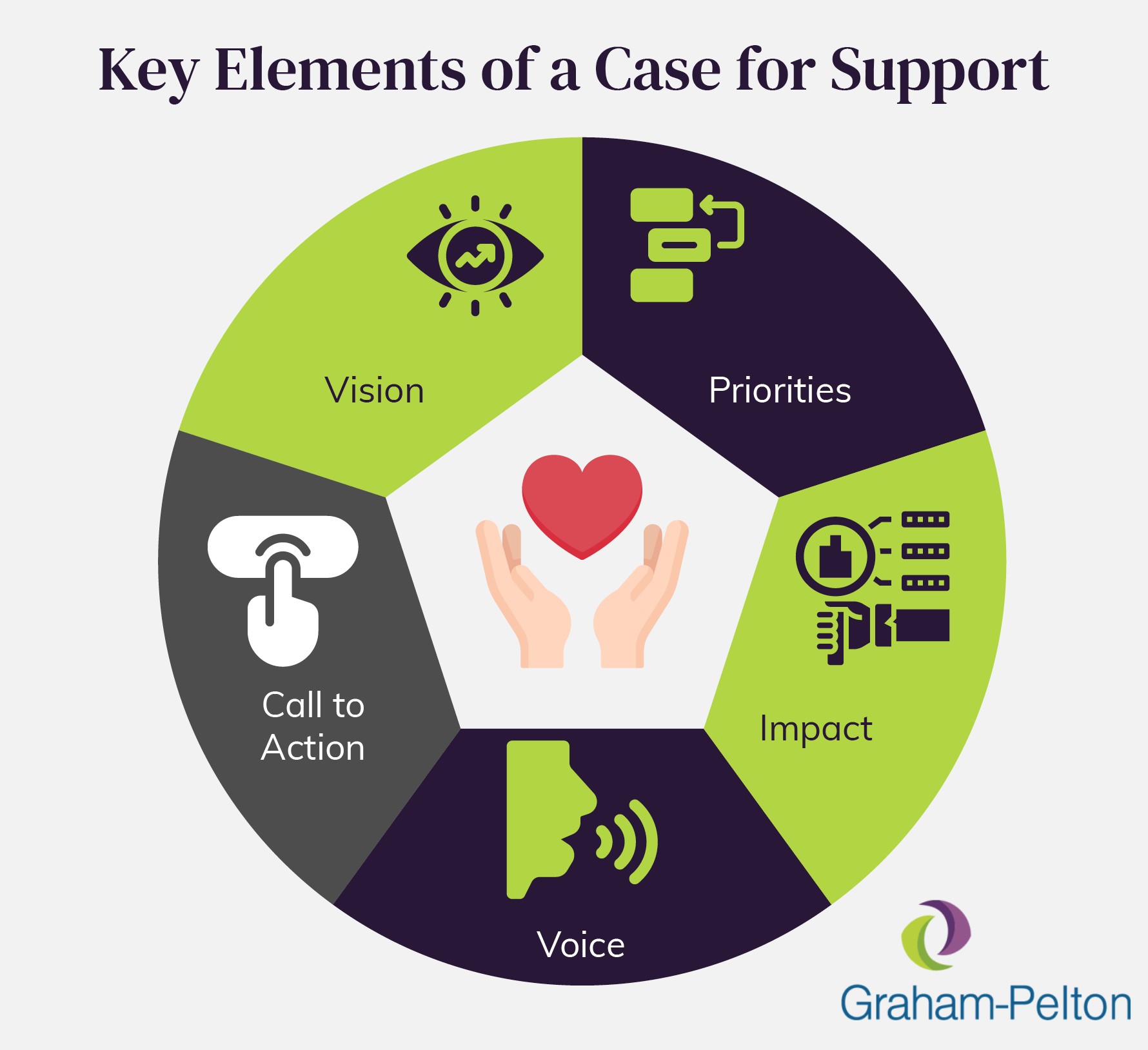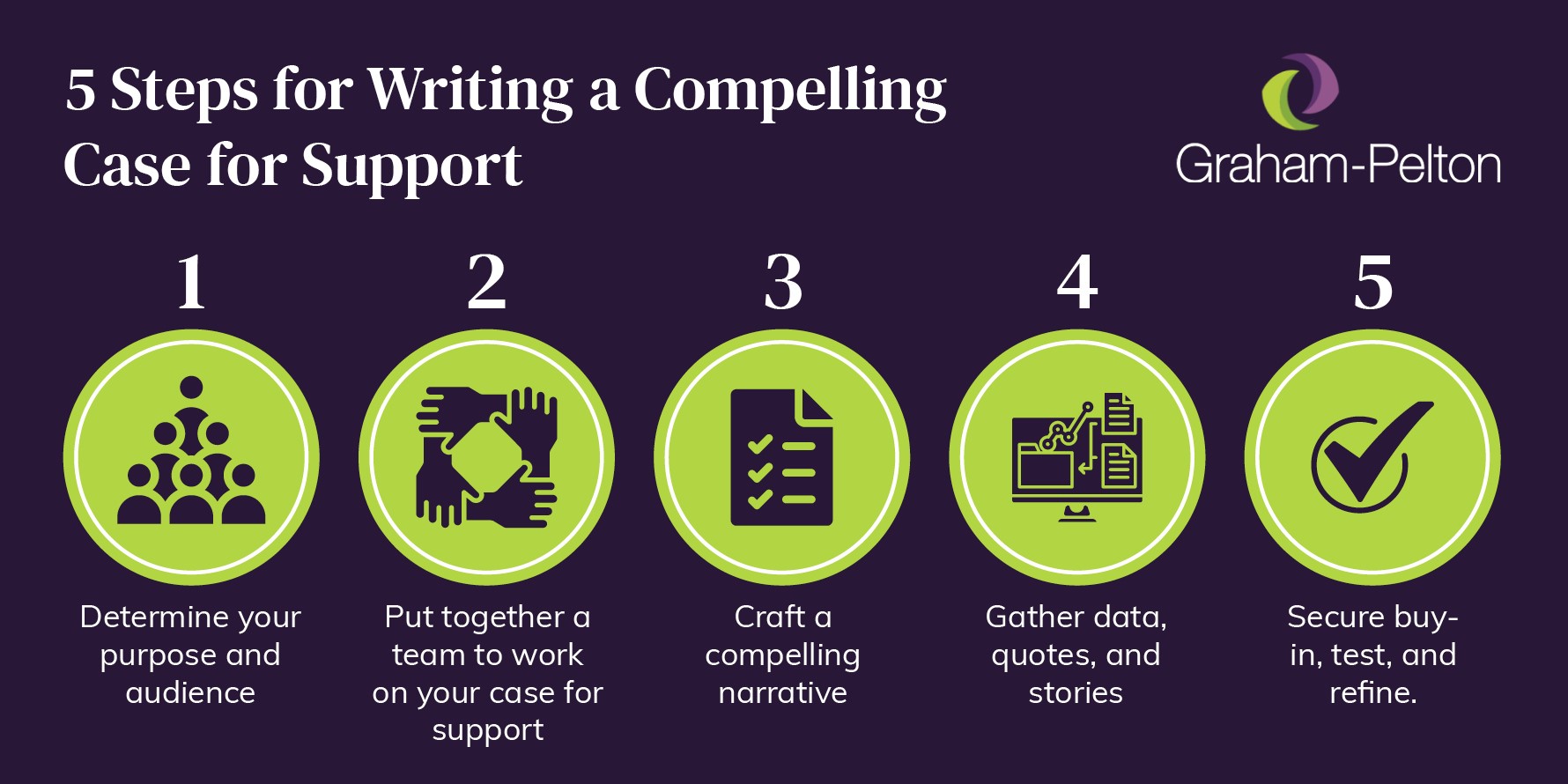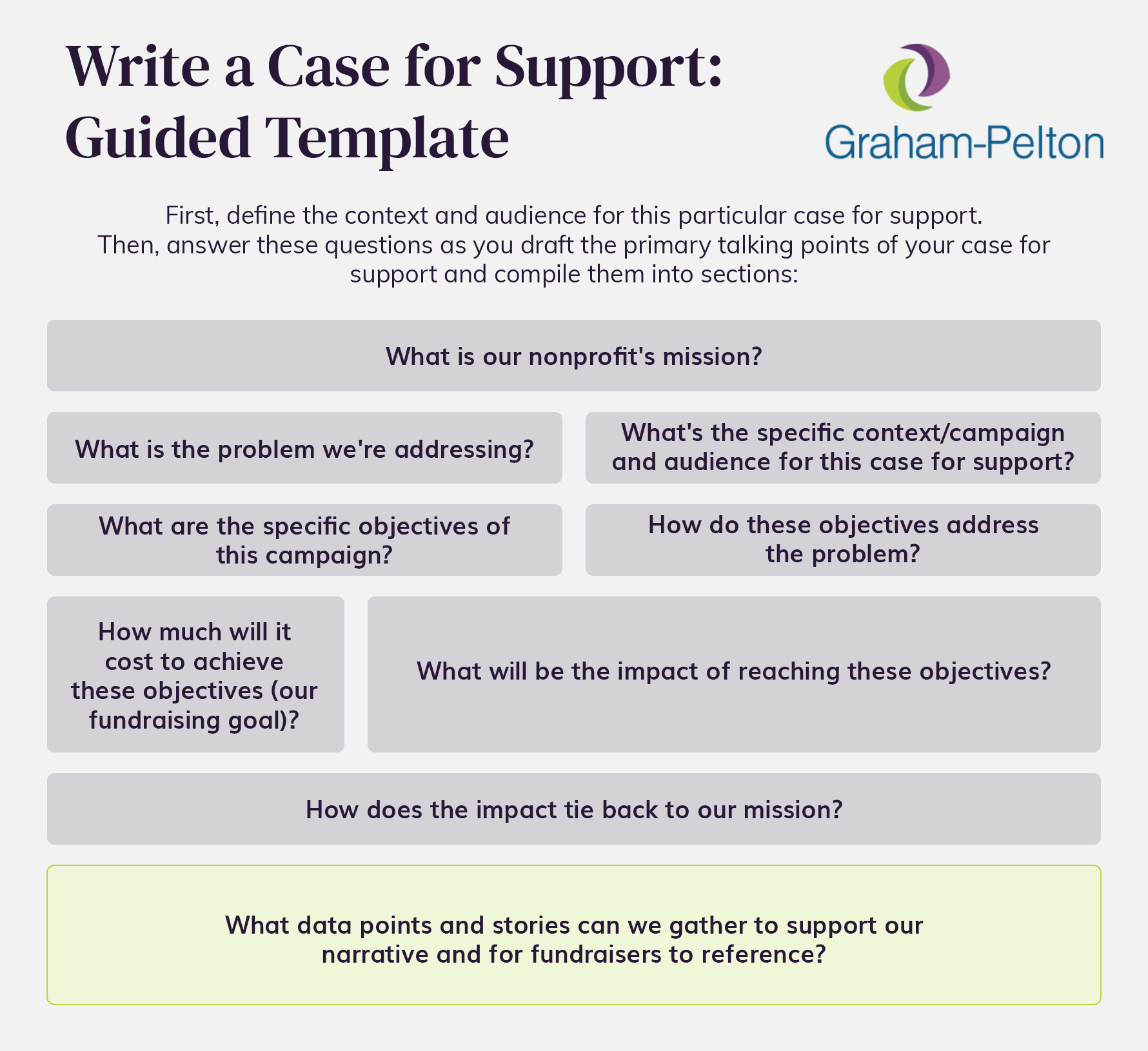
As every nonprofit professional knows, each new capital campaign or other fundraising initiative is a challenge. Even when you understand your audience and why they choose to give, carefully crafting your messages and appeals to meet the moment is essential.
After all, there are so many questions to address to make a compelling pitch: Why should donors support this new project? What will it accomplish in concrete terms? How does it relate to your organization’s overall vision and mission? A one-size-fits-all appeal won’t serve your nonprofit (or your constituents) well.
This is why creating a compelling case for support is a critical first step for launching any new initiative.
An effective case for support can galvanize and motivate existing supporters and inspire new donors to share your vision. It gives your entire team a shared language to use when crafting new messages, discussing the campaign, and soliciting donors.
We’ve rounded up all the essential context and expert tips you’ll need to approach your next case for support with confidence:
- Fundraising Case for Support Fundamentals
- 5 Key Elements of a Case for Support
- How to Write a Case for Support: 5 Steps & Free Template
- Common Mistakes to Avoid
With a solid understanding of the essentials (and some expert support), you’ll be able to create a case for support for any fundraising need—your next capital campaign, annual campaign, and general year-round appeals alike.
Fundraising Case for Support Fundamentals
Let’s start by covering some essential context about nonprofit cases for support:
What is a case for support?
A case for support is your core fundraising message, distilled into various printed or digital materials, that shows prospective donors what your organization will accomplish with the donations it raises and how their support will drive that impact.
You can develop a case for support for any fundraising purpose, but they’re typically tied to specific campaigns. A case should clearly answer key questions that donors may have about your fundraising initiative so that it can serve as a handy, standardized roadmap for your development teams and frontline fundraisers.
Why do nonprofits need cases for support?
The primary function of a case for support is to lay out a thorough, consistent message for your campaigns and fundraising messaging. By creating a case for support early in a campaign, you can also give yourself time to test and refine it, leading to the most effective messaging possible that will generate better fundraising results.
When is a case for support used?
A case for support is valuable at all stages of the fundraising process. It clarifies messaging for gift officers to use in conversations and solicitations with high-level prospects. It also lays out key talking points and summaries that are helpful for broader messaging and marketing, ensuring coherence across the campaign.
Are there different types of cases for support?
Cases for support are generally created for discrete fundraising campaigns, particularly capital campaigns. These large, multi-year endeavors require a lot of planning, consistency, and coherence, so the roadmap provided by an effective case is especially valuable.
However, nonprofits can create cases for support for any fundraising situation—annual campaigns, peer-to-peer campaigns, and specific giving programs like grateful patient or alumni giving, to name a few examples. Most organizations also create an overarching case for support for their general marketing and fundraising needs.
How do you create a case for support?
We’ll take a deeper dive into the steps for creating an effective case for support below.
What Every Case for Support Should Include: 5 Key Elements
Whether you’re writing a general case for support or a case for a specific campaign, there are several key elements and notes that it should hit to effectively connect with and motivate prospects. These include:


- Your Vision. Your donors need to know where your campaign or organization is headed. Think of this as offering them a roadmap for your campaign.
- Your Priorities. Give your donors an idea of what you’re aiming to achieve so that they can understand the impact of their gifts. Provide clear definitions of your campaign’s concrete objectives and what they will cost to achieve.
- Your Impact. This element of your case for support helps donors understand the positive impacts of successfully reaching your objectives. What are the tangible and intangible benefits that success will bring to your constituents and community?
- Your Voice. The case for support should also clearly reflect your organizational or campaign brand. Avoid jargon and generic language, and incorporate unique talking points, like your core values and constituent stories.
- The Call to Action. Sum up your case with a concise, direct appeal that ties it all together—your mission, the problem at hand, your vision and plan for addressing it, and what the impact will be.
To get these elements right, you’ll need to work cross-functionally with different departments of your team to fine-tune the messaging, especially for large-scale or high-stakes campaigns like capital campaigns. This ensures that no one element overshadows another, helps maintain more accurate and consistent branding, and engages internal stakeholders in the process.
Reminder: What a Case for Support is Not
As you begin thinking through these elements and how you might approach them for your next campaign or fundraising push, keep this important point in mind: A case for support is not a single document but rather the set of arguments and details used to create it (and many other campaign materials).
Because cases for support are meant to be flexible tools for appealing to different contexts and donor audiences with your campaign messaging, locking yourself into a single document too early could become detrimental, limiting your vision and the case’s ultimate utility.
Of course, the design and presentation of your case for support materials are very important later once you’re in active discussions with donors.
But first, focus on nailing these key elements and following the steps discussed below before focusing too heavily on the tangible forms that your case will take. This also makes it much easier to make adjustments to your case without needing to redo expensive printed brochures!
How to Write a Case for Support: Our 5 Recommended Steps
Let’s take a closer look at the specific steps to follow when putting together a new case for support:


1. Determine your purpose and audience.
The general purpose of your case for support is, of course, to communicate why someone should support your organization or a specific campaign. But to write a truly compelling case for support, you’ll need to get more specific than that.
To aid your writing and make your case for support appeal to readers on a more personal level, determine a specific purpose and ideal donor persona that you’ll address in your writing. For example, you may identify your target supporter as a middle-aged suburban mother with two kids who is passionate about her children’s education. Your purpose may be to get her to donate $500 to your campaign to revamp the library’s inventory.
Because this “ideal” audience and purpose only serve to help you write more personally, it is not information that you will share with the reader. It also does not mean that you only want that type of donation from that type of person. This practice simply helps you avoid writing too generally and keeps your case for support focused on the specific outcome you are after.
2. Form a team to work on your case for support.
To ensure that you’re communicating your case effectively and in a manner that matches your organization’s standards, it’s helpful to put together a team of internal stakeholders who can provide input. This step helps ensure that you delegate tasks and secure buy-in as you go, which is especially important for major campaigns.
While they don’t all need to play an equal role in the process, having feedback from a variety of voices within your organization will be very helpful. These teams typically include:
- Key senior leadership
- Key board members
- A few members of your program staff
- Development staff
- Volunteers
With internal buy-in and an accurate perception of your case for support, you can better balance external expectations with the elements you need to communicate.
3. Craft your key elements into a compelling narrative.
Work with your team to define the key elements discussed above—your vision, priorities, impact, voice, and call to action. With these elements in mind, draft a concise outline of the important talking points that need to be covered in a thorough case for support:
- The problem that your campaign or mission as a whole works to address
- Your plan for combatting it, in specific terms
- Your fundraising goal (or how much your plan will cost to implement)
- What the impact of your success will be
- Why donors should get involved and how their support will drive the impact
With this framework in place, you can then expand your case for support with compelling details that will make it effective as a persuasive, holistic narrative.
Flesh out the sections of your outline to provide more detail. Gather data that illustrates the problem your campaign is addressing and its projected impact. Compile a few stories or direct testimonials from constituents about the impact of past funded programs and projects.
Remember, don’t worry about images or visuals yet—focus on getting the narrative right. Here are two important tips to keep in mind as you put pen to paper:
- Keep your writing concise and clear. Brevity is key! The case for support should be an adaptable roadmap for your fundraisers in different contexts, not a multi-page, extremely detailed rulebook.
- Use a strengths-based approach. Focus on the strengths of your organization and how they will help drive this project forward. Clearly define the problems and needs involved, but emphasize your plan and why you’re confident in it.
These tips will help you maintain the clarity and purpose of your outline as you add more information and detail.
4. Gather compelling data, quotes, and stories.
Now that you have a clear narrative, gather information to back up your claims. Are there testimonials from those you serve that illustrate your impact? Do you have stories that bring your mission to life? Are there data points that concretely demonstrate the need or projected impact? A few sources of information that can be helpful include:
- Your mission and strategic plan
- Specifics about your program or project (fundraising goal, timeline, key leadership, etc.)
- Costs, budgets, and/or how you intend to spend the dollars you raise
- Impact stories and statistics
- Quotes and testimonials
Consider appending a short “library” of these details to your case for support so that fundraisers can easily reference them later once the campaign is underway. Your gift officers, program leaders, and marketers can then easily adapt their messaging and discussions as needed to best connect with their current audience.
5. Secure buy-in and test your case for support.
With a complete case for support in hand, it’s time to secure buy-in from organizational or campaign leaders. Confirming your team’s vision is aligned is important to avoid wasting time—when everyone’s on the same page, you can hit the ground running.
You’ll also need to seek feedback on your case for support to identify any improvements. Other internal stakeholders can provide feedback, but some of the most valuable input will come from external stakeholders since they’re the audience you’re seeking to reach. They can include:
- Constituents who use your organization’s services
- Existing and target donors
- Existing and target corporate partners
During a capital campaign, fielding feedback on your case for support and preliminary plans happens during a feasibility study or campaign planning study. However, this is a useful step in any fundraising context because it helps you refine your case for support for maximum effectiveness and ensures that its framework will lead to clear, compelling, coherent messaging later.
Make any adjustments as needed, and share your finalized case for support with the relevant teams in your nonprofit. Ensure that it’s easily accessible to anyone who may need it.
Try it Yourself: Case for Support Template
Ready to try creating your own case for support? Use this guided template to walk through the key components it should include:


Answer these questions as you work through the template:
- What is our nonprofit’s mission?
- What is the problem we seek to address?
- What is the specific context or campaign for this case for support?
- Who are we addressing: a specific donor segment or our supporters in general?
- How will this campaign or project address the problem?
- What are the specific objectives of our plan?
- How much will it cost to achieve these objectives?
- What will be the impact of success?
- How does this impact tie back to our mission?
- What data points and stories can we gather to support our narrative?
Common Mistakes to Avoid in Your Next Fundraising Case for Support
Let’s review a few common mistakes to keep in mind as you develop your case for support:
- Limiting your vision too quickly.
- The most common mistake with nonprofit cases for support is starting the development process by thinking of your case as a single brochure or document. It should provide a persuasive framework and library of details that you can later adapt into all the one-pagers, brochures, emails, and social media posts you’ll need during the campaign.
- Not securing organizational buy-in early.
- As mentioned above, changing your case for support or reprinting finalized materials will waste time and money. Make sure everyone’s on the same page about the vision, purpose, impact, and goals of your campaign long before you call the case for support complete.
- Making your case for support difficult to find.
- Especially for major campaigns, many different teams and individuals in your organization will need the case for support—fundraisers, marketers, board members, and more. When you’re ready to share it, broadly announce it to your entire organization and explain where to access it. Uploading it to a shared cloud file-sharing system will be your best bet to ensure team-wide accessibility.
- Not striking the right balance of urgency and confidence.
- When describing problems and your plans for addressing them, it’s important to not whitewash the problems or over-emphasize them to the point of seeming pessimistic or cynical. Focus on your strengths and your plan, acknowledge your challenges and needs, and use them to more clearly articulate the impact that support will have.
- Not getting expert support when it’s needed.
- Sometimes professional support is necessary for taking your case for support to the next level and maximizing its usefulness. Fundraising consultants, ideally specialized in your sector like healthcare or education, can bring an informed, objective perspective and ensure that your case for support hits all the right notes. This kind of support is especially helpful for large-scale capital campaigns since they’re such big investments of your time and resources.
How Graham-Pelton Can Help Craft Your Case for Support
At Graham-Pelton, we believe that the true value of creating a case for support is in the process.
The iterative, dynamic process of working through the messaging with your internal and external stakeholders creates ownership, engagement, and affinity. That’s why we emphasize our Visioning Sessions, which are specifically designed to help you connect with donors on an emotional level as you appeal to them for support in your campaign.
Combining decades of firsthand experience with recognized behavioral and cognitive research, marketing best practices, and change management theories, we’ve developed a 5-part framework that helps fundraisers organize their thinking.
Our framework can work for any organization to help craft an outstanding case for support, no matter its unique purpose. We guide you through the entire process, resulting in not only a polished final product but also shared clarity about your nonprofit’s messaging and mission—true assets to drive both immediate and long-term success.
Want to discuss your next campaign with our experts and learn more about our case for support methodology? Please get in touch—we’ll be happy to help.
To learn more about nonprofit development best practices, explore these additional resources from the Graham-Pelton team:
- Conducting a Capital Campaign Feasibility Study: 5 Steps
- Why Donor Qualification Is Key to Fundraising Success
- Healthcare Fundraising: Overview & 15 Modern Strategies
- Prospect Portfolio Management: The 3-Step Strategy You Need
- Employee Retention Strategies for Nonprofits: Complete Guide




